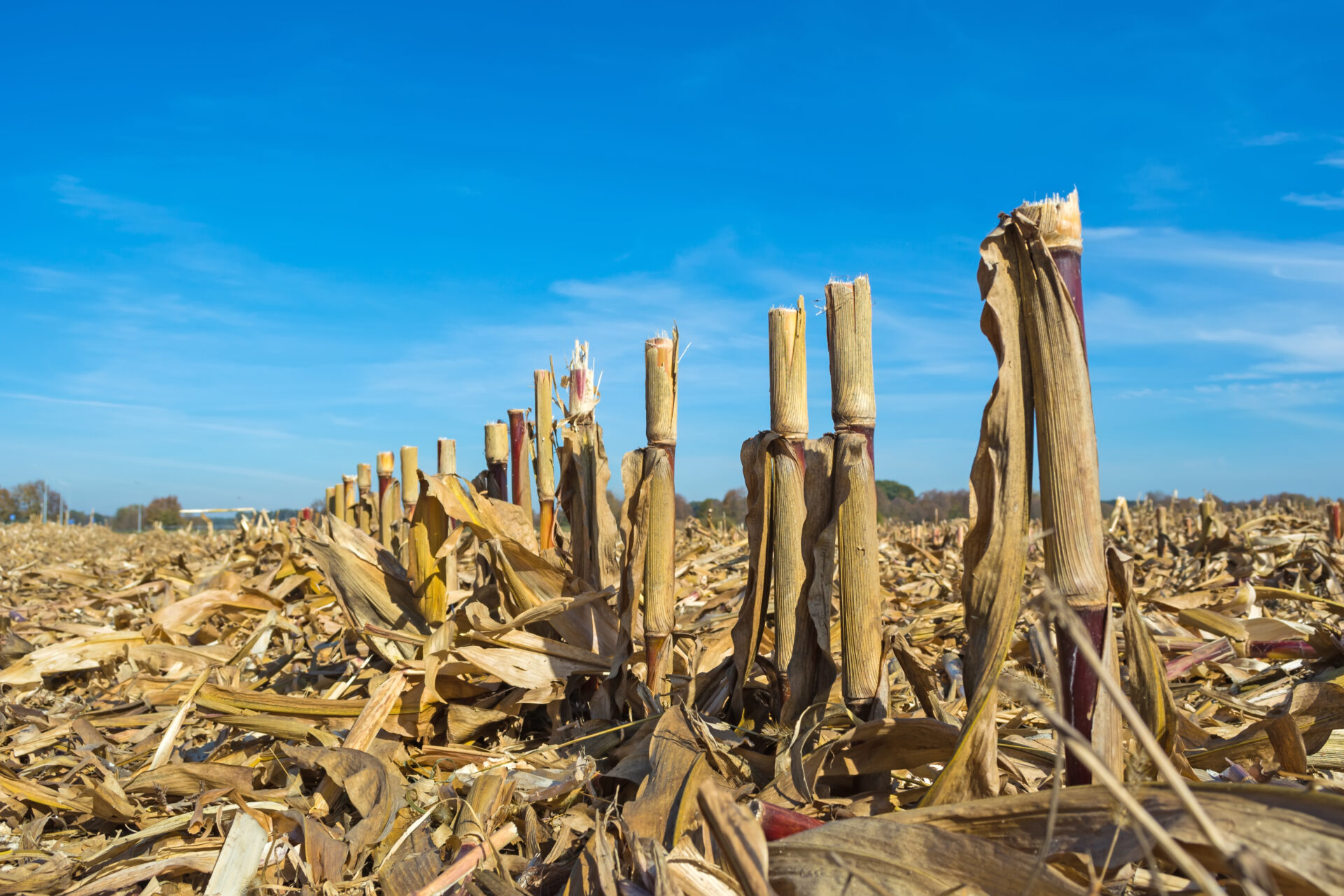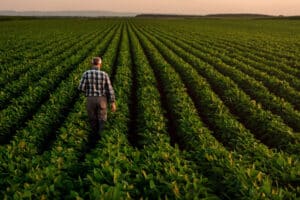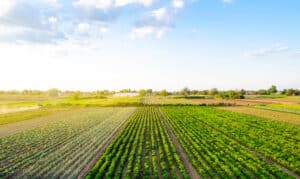Nov 12, 2025

All growers plant their seeds with optimism at the beginning of the season. Yet, that optimism can be quickly squashed. Whether your area is experiencing torrential downpours, or if you’re watching the edges of your sprouting plants turn brown due to drought conditions, the weather can disrupt the program you planned for your seeds and crop.
Or perhaps you’re not quite sure what’s happening, but your crops aren’t progressing as you’d expect them to this season.
That’s where a side-dress application comes in – but we don’t mean just any side-dress application. Rather than relying on fertilizer alone to save the day, consider pairing it with a product that feeds hungry soil microbes and builds soil health, like PhycoTerra. Feeding soil microbes in a side-dress application is a new way to approach a side-dressing.
From increasing nutrient availability, to making the most of your second / supplementary fertilizer application and improving soil health, a strategic side-dress application can increase your crop yield potential.

There are three overlapping management practices that growers need to be aware of when it comes to nutrient and soil management. Each plays a distinct role in supporting your overall soil health and yield potential.
The physical management of your soil includes practices that alter the soil’s structure, aggregation and water holding capacity.
Common physical management practices include:
Some of these practices can do more harm to your soil than good, especially when repeated consistently over long periods of time.
The chemical management of your soil includes products that you add to your soil to enhance and support crop growth. Common examples of chemical management include:
This, and physical management are the two most common management practices implemented by growers.
The biological management of your soil includes practices that leverage microorganisms, such as bacteria and fungi as partners in the field to enhance and support crop growth. Some common biological management practices include:
This is often the least leveraged aspect of soil management, yet it can have a notable impact on your yield potential. By improving the living components of soil, and improving soil health, you’ll also be improving the results of your chemical management (like fertilizer efficiency).
Some practices may have different aspects that impact multiple spheres of influence. For example, planting a cover crop can help break up compact soil while also feeding and supporting hungry soil microbes.
One strategic way to improve your soil health and yield potential is to pair your side-dress fertilizer application with a soil microbe food, which makes the most of your fertilizer.
The nutrients available in your soil depend on many factors that should be considered before side-dressing. Below are some of those factors to consider.
In many cases, growers will determine that a side-dress application is worth the investment and will add a fertilizer application to support their growing crops.
A side-dress application is an application of fertilizer or soil amendments between the rows of growing crops. Rather than broadcasting the application over the entire field, a side-dress application places nutrients in close proximity to root zones. It takes place before crops get too big, which helps avoid damaging the plant and the root system via equipment passes.
If you want to make the most of your side-dress application, consider pairing your product with a soil microbe food. This will put the beneficial microbes in your soil to work, so they can support your crops and soil health.
Make sure your side-dress products are compatible so everything can be applied in one pass.

There are lots of benefits to applying a side-dress application. It can be a good distribution of labor and equipment, especially in wet springs when there is a small planting window and seeds are prioritized over fertilizer applications.
By side-dressing, the fertilizer application supports plants early in the planting season, when there is a greater potential for nitrogen loss due to excess precipitation, and during a time when nutrient uptake is increasing. This increased uptake helps ensure less nitrogen is lost, even if there is excess precipitation.
The downside of a side-dress application is that for some growers, the extra cost in product, diesel, and labor may not lead to a high enough increase of their investment. Also, applying a side-dress application can be tricky, especially if your plants are more mature. Timing is key. For example, corn dressed at V5 or later will likely mean knocking down some stalks while applying a side-dress application.
Also, side-dressing on wet fields is not advisable given the potential for soil compaction. If your area is experiencing excessive moisture, consider applying a side-dress application once the fields have dried out, or during a dry weather period.
If you know your field is lacking in the needed nutrients to support your crops, the benefits will likely outweigh the risk.
When you apply a side-dress application, the intention is to support your crops and help them grow. Yet, some of your application may go to waste if you don’t have an active and healthy microbiome.
Beneficial microbes are key to making the most of your fertilizer application and for building healthy soil. Well-fed microbes create a unique mode-of-action with proven on-farm results. A healthy, diverse and active microbiome can:
All of which play a role in boosting your yield potential and return on investment.
By feeding your beneficial microbes a superior soil microbial food, you can improve your soil health and crop yield potential. A carbon-rich product like PhycoTerra and PhycoTerra Organic feeds native microbes in your soil.
Our award winning product feeds a diverse range of beneficial microbes with a microalgal food source, which increases microbe activity by up to 33x. It’s applicable for a wide range of soil types, regardless if you’re planting in sandy soils on the coast or high levels of clay in the midwest.
Compatible with all crop inputs, its easy-to-use liquid formulation provides a convenient addition to your side-dress application. It also has an exceptional shelf life of up to 2 years.
Investing in your soil microbes is one way to strengthen your yields and return on investment.

When adding PhycoTerra as a side-dress application, it increases the abundance and diversity of soil microbes, plays a key role in nutrient availability and provides a balanced crop nutrition program all season long.
To make the most of your fertilizer inputs, we recommend applying 1 quart per acre per application.
As you can see, PhycoTerra has exceptional compatibility with whatever product you’re pairing it with.
If you weren’t able to support your soil microbes at planting (with a product like PhycoTerra ST), the earlier you can support your soil microbes with a side-dress application, the better!
PhycoTerra can be added in a side-dress application to many different crops, like:
We’ve also conducted trial data on both corn and peanuts, both of which saw yield improvements and a notable ROI.
| Year | Location | Grower Standard | Average Yield with PhycoTerra | Yield Change | ROI |
|---|---|---|---|---|---|
| 2021 | Milford Center, OH | 171 bu/acre | 195 bu/acre | +17% | 15:1 |
| 2021 | Aurora, NE | 241 bu/acre | 259 bu/acre | +8% | 10:1 |
| 2021 | Wahoo, NE | 218 bu/acre | 224 bu/acre | +3% | 3:1 |
| Year | Location | Grower Standard | Application | Average Yield | Yield Change | ROI |
|---|---|---|---|---|---|---|
| 2020 | Tifton, GA | 3,300 lb/acre | 1 qt/acre applied in-furrow at planting, 1 quart applied via side-dress 30 days after planting | 3,574 lb/acre | +8% | 3:1 |
| 2020 | Tifton, GA | 3,300 lb/acre | 2 qt/acre applied in-furrow at planting, 2 quart applied via side-dress 30 days after planting | 3,915 lb/acre | +19% | 3:1 |

Soil microbes aren’t the only hard-working microbes on your farm that need feeding. You can find beneficial microbes living in the spermosphere, rhizosphere, phyllosphere and detritusphere.
Spermosphere: The spermosphere is a short lived 2- to 12-mm area around the seed that is incredibly impactful to your crop’s overall success. This is your crop’s first encounter with the real world. While a seed naturally secretes enzymes and metabolites, it’s not enough to activate all the surrounding beneficial microbes.
Rhizosphere: This is the area between the soil and roots where microbes live in a symbiotic relationship. Microbes receive exudates from the roots and release nutrients for crops. When you apply a side-dress application, the beneficial microbes in the rhizosphere are the ones that reap the benefits.
Phyllosphere: This is a microscopic region around the leaves and above ground tissue of the plant where microbes live. There are less microbes in the phyllosphere than the other spheres, likely because of the harsh living conditions for these microbes, which support your crop during times of abiotic stress.
Detritusphere: The detritusphere is an organic matter rich zone in your soil where decaying plant matter and animal material is broken down by bacteria, fungi and detritivores. Here, microbes cycle nutrients so they are accessible for your crops as a slow nutrient release. But, if your beneficial microbes are starving or dormant, they’ll be unable to help break down any remaining crop residue. This hurts your yields, as future crops can’t access the nutrients of your previous year’s crop residue.
By supporting microbes with your side-dress application, you have the potential to support beneficial microbes across multiple spheres.
For example, your side-dress application will support beneficial microbes in the rhizosphere. Yet, these microbes can sometimes end up in the phyllosphere, either transferred during germination, or sometimes when water splashes the soil and it lands on the plant, it can also transfer soil microbes to the phyllosphere.
Supporting one group of microbes has the potential to support multiple groups of microbes, who can then go to work supporting your soil health, crops, and yield potential.

There are a lot of agricultural practices that can negatively impact soil health. Investing in your soil and supporting your soil microbes with a product like PhycoTerra is one way to counteract those negative impacts and improve your overall soil health – which should be a major priority for every grower.
The crops that we plant today, or that we planted earlier this spring are temporary. The inputs we add to our fields are temporary. If we take care of our soil, on the other hand, it can last forever. Investing in supporting your soil microbes is not only a way to impact today’s yields, but a way to protect your yields for years to come.
Want to talk to an expert about your side-dress application, and learn more about the impact PhycoTerra could have on your yield potential for years to come? Fill out a contact form to get started.
Note: All trial data is current as of blog posting. For the most up to date trail data, please visit our trials page.
Preserving the Future of Farming

Learn more about our mission to keep farming economically and ecologically sustainable.
Learn MoreJoin our mailing list to learn more and receive special promotions.
© 2026 Heliae Development, LLC DBA PhycoTerra®.
All Rights Reserved. | Sitemap
